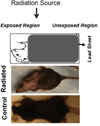Radiation fibrosis of the vocal fold: from man to mouse
- PMID: 23242839
- PMCID: PMC3596010
- DOI: 10.1002/lary.23735
Radiation fibrosis of the vocal fold: from man to mouse
Abstract
Objectives/hypothesis: To characterize fundamental late tissue effects in the human vocal fold following radiation therapy. To develop a murine model of radiation fibrosis in order to ultimately develop both treatment and prevention paradigms.
Design: Translational study using archived human and fresh murine irradiated vocal fold tissue.
Methods: 1) Irradiated vocal fold tissue from patients undergoing laryngectomy for loss of function from radiation fibrosis was identified from pathology archives. Histomorphometry, immunohistochemistry, and whole-genome microarray, as well as real-time transcriptional analyses, were performed. 2) Focused radiation to the head and neck was delivered to mice in a survival fashion. One month following radiation, vocal fold tissue was analyzed with histomorphometry, immunohistochemistry, and real-time PCR transcriptional analysis for selected markers of fibrosis.
Results: Human irradiated vocal folds demonstrated increased collagen transcription, with increased deposition and disorganization of collagen in both the thyroarytenoid muscle and the superficial lamina propria. Fibronectin were increased in the superficial lamina propria. Laminin decreased in the thyroarytenoid muscle. Whole genome microarray analysis demonstrated increased transcription of markers for fibrosis, oxidative stress, inflammation, glycosaminoglycan production, and apoptosis. Irradiated murine vocal folds demonstrated increases in collagen and fibronectin transcription and deposition in the lamina propria. Transforming growth factor (TGF)-β increased in the lamina propria.
Conclusion: Human irradiated vocal folds demonstrate molecular changes leading to fibrosis that underlie loss of vocal fold pliability occurring in patients following laryngeal irradiation. The irradiated murine tissue demonstrates similar findings, and this mouse model may have utility in creating prevention and treatment strategies for vocal fold radiation fibrosis.
Copyright © 2012 The American Laryngological, Rhinological, and Otological Society, Inc.
Conflict of interest statement
Conflict of Interest: None
Figures
















Similar articles
-
Pathologic effects of external-beam irradiation on human vocal folds.Ann Otol Rhinol Laryngol. 2011 Nov;120(11):748-54. doi: 10.1177/000348941112001109. Ann Otol Rhinol Laryngol. 2011. PMID: 22224317
-
Establishment of a radiation-induced vocal fold fibrosis mouse model.Biochem Biophys Res Commun. 2022 Apr 23;601:31-37. doi: 10.1016/j.bbrc.2022.02.065. Epub 2022 Feb 20. Biochem Biophys Res Commun. 2022. PMID: 35220011
-
Irradiated macula flava in the human vocal fold mucosa.Am J Otolaryngol. 2008 Sep-Oct;29(5):312-8. doi: 10.1016/j.amjoto.2007.09.007. Epub 2008 Jun 13. Am J Otolaryngol. 2008. PMID: 18722887
-
Fibronectin: an interesting vocal fold protein.J Voice. 2002 Sep;16(3):310-6. doi: 10.1016/s0892-1997(02)00102-9. J Voice. 2002. PMID: 12395983 Review.
-
Current treatment of vocal fold scarring.Curr Opin Otolaryngol Head Neck Surg. 2005 Jun;13(3):143-7. doi: 10.1097/01.moo.0000162261.49739.b7. Curr Opin Otolaryngol Head Neck Surg. 2005. PMID: 15908810 Review.
Cited by
-
Comparative characteristics of laryngeal-resident mesenchymal stromal cell populations isolated from distinct sites in the rat larynx.Stem Cell Res Ther. 2017 Sep 29;8(1):200. doi: 10.1186/s13287-017-0650-y. Stem Cell Res Ther. 2017. PMID: 28962587 Free PMC article.
-
Evaluating Post-Radiotherapy Laryngeal Function with Laryngeal Videostroboscopy in Early Stage Glottic Cancer.Front Oncol. 2017 Jun 12;7:124. doi: 10.3389/fonc.2017.00124. eCollection 2017. Front Oncol. 2017. PMID: 28660173 Free PMC article.
-
The Histological Background of Recurrence in Laryngeal Squamous Cell Carcinoma: An Insight into the Modifications of Tumor Microenvironment.Cancers (Basel). 2023 Jun 20;15(12):3259. doi: 10.3390/cancers15123259. Cancers (Basel). 2023. PMID: 37370868 Free PMC article. Review.
-
Change in Voice Quality after Radiotherapy for Early Glottic Cancer.Cancers (Basel). 2022 Jun 17;14(12):2993. doi: 10.3390/cancers14122993. Cancers (Basel). 2022. PMID: 35740656 Free PMC article.
-
Early Cellular Response to Radiation in Human Vocal Fold Fibroblasts.Ann Otol Rhinol Laryngol. 2016 May;125(5):425-32. doi: 10.1177/0003489415615140. Epub 2015 Nov 8. Ann Otol Rhinol Laryngol. 2016. PMID: 26553661 Free PMC article.
References
-
- Fung K, Lyden TH, Lee J, et al. Voice and swallowing outcomes of an organ-preservation trial for advanced laryngeal cancer. Int J Radiat Oncol Biol Phys. 2005;63:1395–1399. - PubMed
-
- Mendenhall WM, Parsons JT, Buatti JM, Stringer SP, Million RR, Cassisi NJ. Advances in radiotherapy for head and neck cancer. Semin Surg Oncol. 1995;11:256–264. - PubMed
-
- Fung K, Yoo J, Leeper HA, et al. Vocal function following radiation for non-laryngeal versus laryngeal tumors of the head and neck. Laryngoscope. 2001;111:1920–1924. - PubMed
-
- Hirano S, Bless DM, del Rio AM, Connor NP, Ford CN. Therapeutic potential of growth factors for aging voice. Laryngoscope. 2004;114:2161–2167. - PubMed
-
- Hirano S, Nagai H, Tateya I, Tateya T, Ford CN, Bless DM. Regeneration of aged vocal folds with basic fibroblast growth factor in a rat model: a preliminary report. Ann Otol Rhinol Laryngol. 2005;114:304–308. - PubMed
Publication types
MeSH terms
Substances
Grants and funding
LinkOut - more resources
Full Text Sources
Medical

